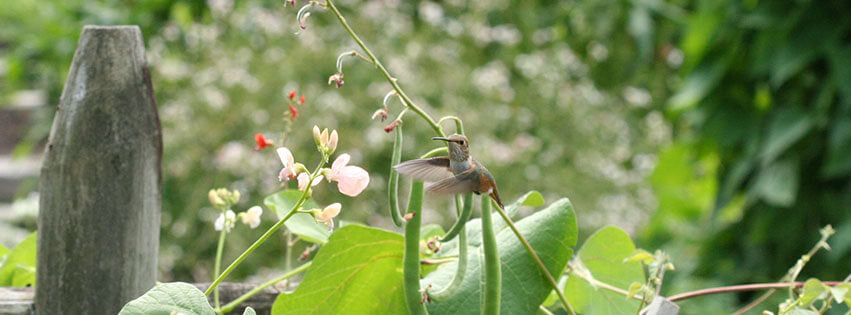Learn how to attract hummingbirds. The two most common hummingbird species in British Columbia are the Rufous Hummingbird (Selasphorus rufus) and Anna’s Hummingbird (Calypte anna). The Rufous is a migratory species that usually appears in the Lower Mainland around the middle of March, and stays throughout the summer. These birds migrate as far north as Alaska, and then take their winter months primarily in Mexico.

Anna’s Hummingbirds are found mainly along coastal North America from Alaska in the north down to Baja California. These birds often stay in one area all year round, and they can be quite territorial. Anna’s Hummingbirds can be seen at the UBC Botanical Garden (and other sites) twelve months of the year.
Hummingbirds have a poor sense of smell, and select their food sources based on colour and the quality of the available nectar. They develop routes from food source to food source known as trap-lines, and a well planted hummingbird garden will attract visits several times a day. In the right conditions, some hummingbirds will aggressively defend a rich food source from others.
Although the colour red is highly attractive to hummingbirds, they will feed from flowers or feeders of any colour once they establish that it’s a good food source. They will look for the shape of the flower and the abundance and sweetness of its nectar. This list is not exhaustive, but some of the most attractive flowering plants to hummingbirds are:
Begonia Begonia spp.
Bleeding Hearts Dicentra spp.
Butterfly Bush Buddleia davidii
Cardinal Flower Lobelia cardinalis
Columbine Aquilegia spp.
Coral Bells Heuchera sanguinea
Crocosmia Crocosmia spp.
Foxglove Digitalis purpurea
Fuchsia Fuchsia spp.
Geranium Pelargonium spp.
Honeysuckle Lonicera spp.
Impatiens Impatiens spp.
Lantana Lanta camara
Larkspur Delphinium spp.
Licorice Mint Agastache rugosa
Lupins Lupinus polyphyllus
Morning Glory Ipomoea tricolor
Penstemen Penstemen spp.
Petunia Petunia spp.
Sage Salvia officinalis and other Salvia species
Scarlet Runner Bean Phaseolus coccineus
Tobacco Nicotiana alata
Weigela Weiglea spp.
Wild Bergamot Monarda fistulosa
In planning a hummingbird garden, it’s good to include a really diverse mix of flowers — annuals as well as perennials, shrubs as well as vines. This will give the birds a wider variety of feeding options over a longer period in the year.
Hummingbird Feeders
If you don’t have the space for a dedicated hummingbird garden, feeders are a great option. They can be mounted nearly any place that allows for good viewing of the birds as they feed. Wherever you intend to mount or hang a feeder, make sure you have easy access to it for regular cleaning and refilling. Hummingbird feeders should be cleaned frequently — at least once a week, more often in hot weather. If the nectar is allowed to sit in the feeder it can grow mould, so regular washing is essential. Some sources recommend only filling feeders half full, as the birds will not be able to consume a full quantity of nectar before it needs to be discarded and cleaned.
Clean your feeder by filling with warm water and giving it a good shake. If you see black spots of mould develop inside the feeder, remove them with a bottlebrush or add some sand with warm water and try to shake it away. Avoid using detergents for cleaning, if possible.
The nectar mix is very simple: Dissolve ¼ cup (57ml) of regular white sugar in 1 cup (227ml) of warm water. Doing this on the stove works a bit faster, but don’t let the water come to a boil, as it can cause the sugar to caramelize, which can harm the birds. Allow the solution to cool completely, and store any unused nectar in a sealed container in the refrigerator.
The style of feeder you choose is largely a matter of personal taste. You may go for the charm of an antique glass feeder, or the simple design of a glass tube feeder. The HummZinger Fancy hummingbird feeder even features an ant moat to prevent insects from going after Once the birds figure out that it’s a source of good, clean nectar, they may become quite territorial over it. If this happens, consider hanging another feeder out of sight of the first, like on the other side of the house. If activity around your feeders goes down in mid-summer, it’s because more flowers are in bloom, and hummingbirds prefer natural nectar to feeder nectar.

